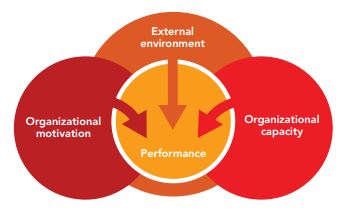How to analyse organizational performance
When carrying out an organization analysis, the first step is to analyse organizational performance using the Organizational Performance Assessment (OPA) tool described below. The next step is to plan relevant actions and interventions, using another practical tool “How to plan organizational change”.
What is organization analysis?
Organizations are “groups of individuals bound by some common purpose to achieve objectives” (North, 1990).
Organization analysis is a diagnostic process that helps to better understand the performance of an organization. It can be undertaken after an initial capacity assessment to obtain a deeper knowledge about the causes of organizational weaknesses and to identify emerging opportunities.
Why carry out organization analysis?
Over the course of their lives, and depending on the stages of their development, organizations face different challenges. For instance, young organizations may be very flexible and full of energy, whilst lacking a clear division of roles and responsibilities or predictable income streams. Conversely, more mature organizations may have formal systems and processes in place, while lacking energy to innovate or the capacity to adapt to change.
Carrying out regular organization analysis allows leaders and members of an organization to assess its internal weaknesses and strengths, external challenges and opportunities. This helps to plan long- and short-term objectives strategically, and to adapt to changing environments with foresight.
How to analyse organizational performance?
The Organizational Performance Assessment (OPA) is the primary tool for assessing organizational performance. It can be applied to any type of organization (government ministries, producer organizations, research or extension organizations, etc.).
The OPA framework assumes that organizational performance is a function of three broad areas: Organizational motivation, Organizational capacity, and the External environment.

- Organizational Performance Assessment framework
Organizational motivation refers to the ability of an organization to mobilize its human capital to reach its goals. Motivation is rooted in an organization’s vision and mission, culture, values and incentive systems - all of which are influenced by the organization’s history.
Organizational capacity refers to an organization’s endowment of resources (i.e. its human, physical and financial capital) and to the systems and processes used for managing this capital (e.g. strategic leadership, programming and process management).
External environment refers to the external factors that facilitate or impede an organization’s performance. These include a country’s political rules, its economic situation, sociocultural norms, etc., as well as the quality of relations that an organization has established with other organizations and stakeholders.

1. Orientation | This is the preliminary conversation between the organization and the external facilitator, during which the reasons for the organizational analysis are established, as well as the readiness of the organization to engage in a self-assessment process. This phase requires skills in interviewing, listening, non- verbal communication, questioning and building trust. | Suggested tools:
|
2. Planning the assessment process | The purpose of this phase is to understand the priority issues affecting organizational performance. Key actions include organizing a consultative workshop to introduce the OPA, and establish the scope and priorities of the assessment. This is the time to agree on which information is needed, how it will be collected, and by when. | Suggested tools:
|
3. Collecting and analysing information | Once the assessment questions have been agreed upon (based on the priority issues identified in the previous phase), the sources of information have been identified, and the methodology has been clarified, the data collection process can begin. | Suggested tools:
|
4. Reflecting and modelling the future | This is when the results of the analysis are communicated within the organization, to initiate a reflection process that can lead to planning for organizational change. Key actions include convening information sessions, distributing memos and circulating a report | Suggested tools:
|
More resources on assessing organizational performance are available in FAO Learning Module 4: Organizational Analysis and Development.
